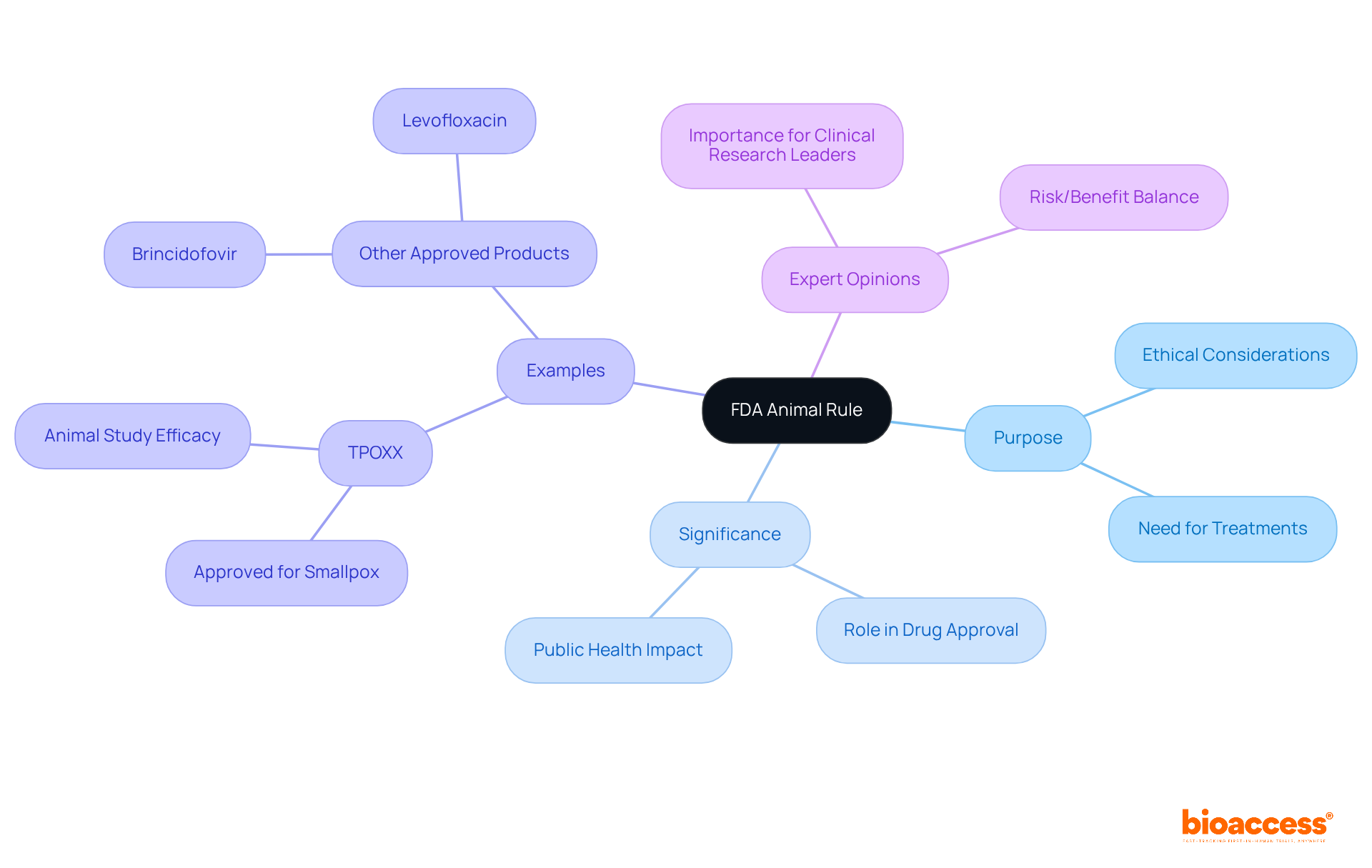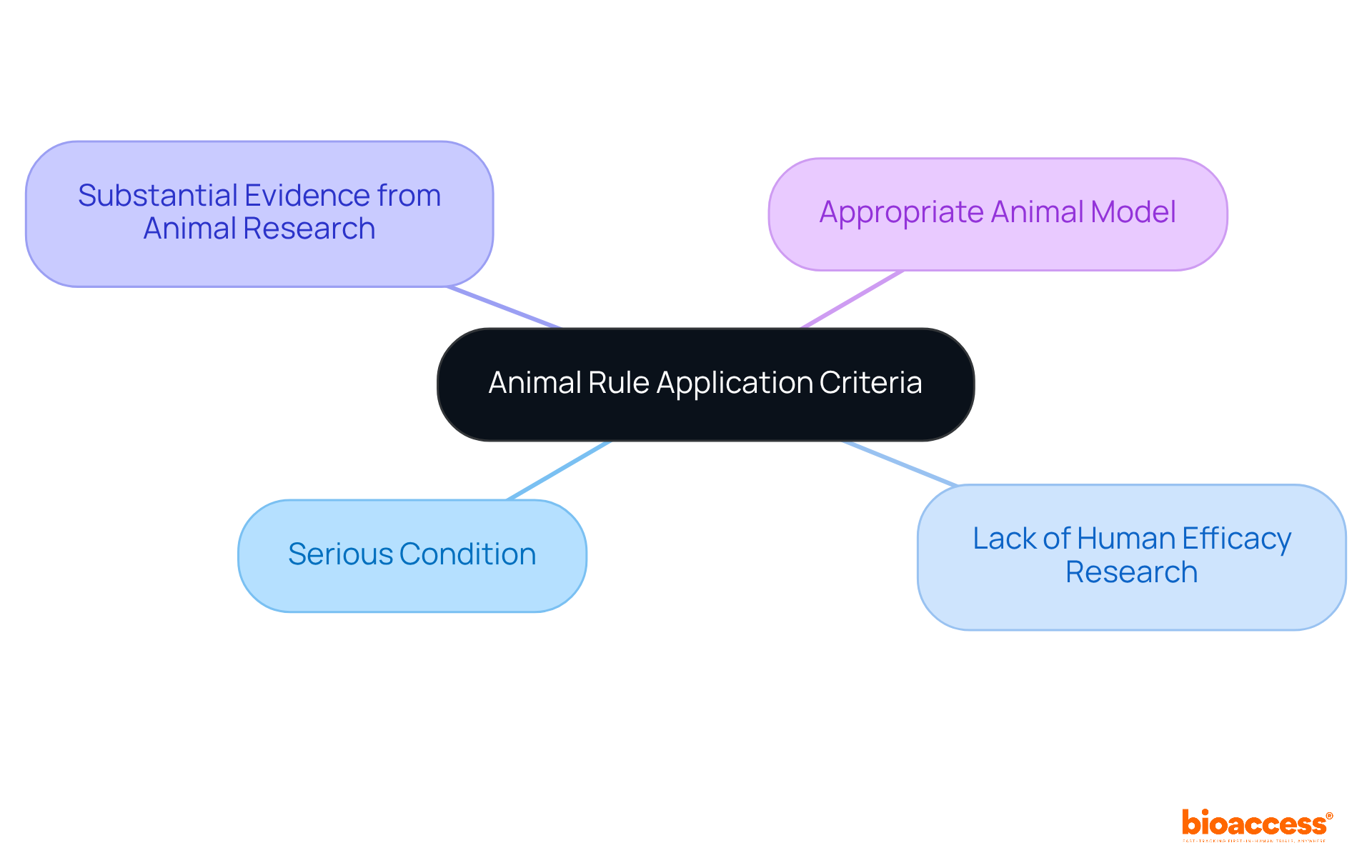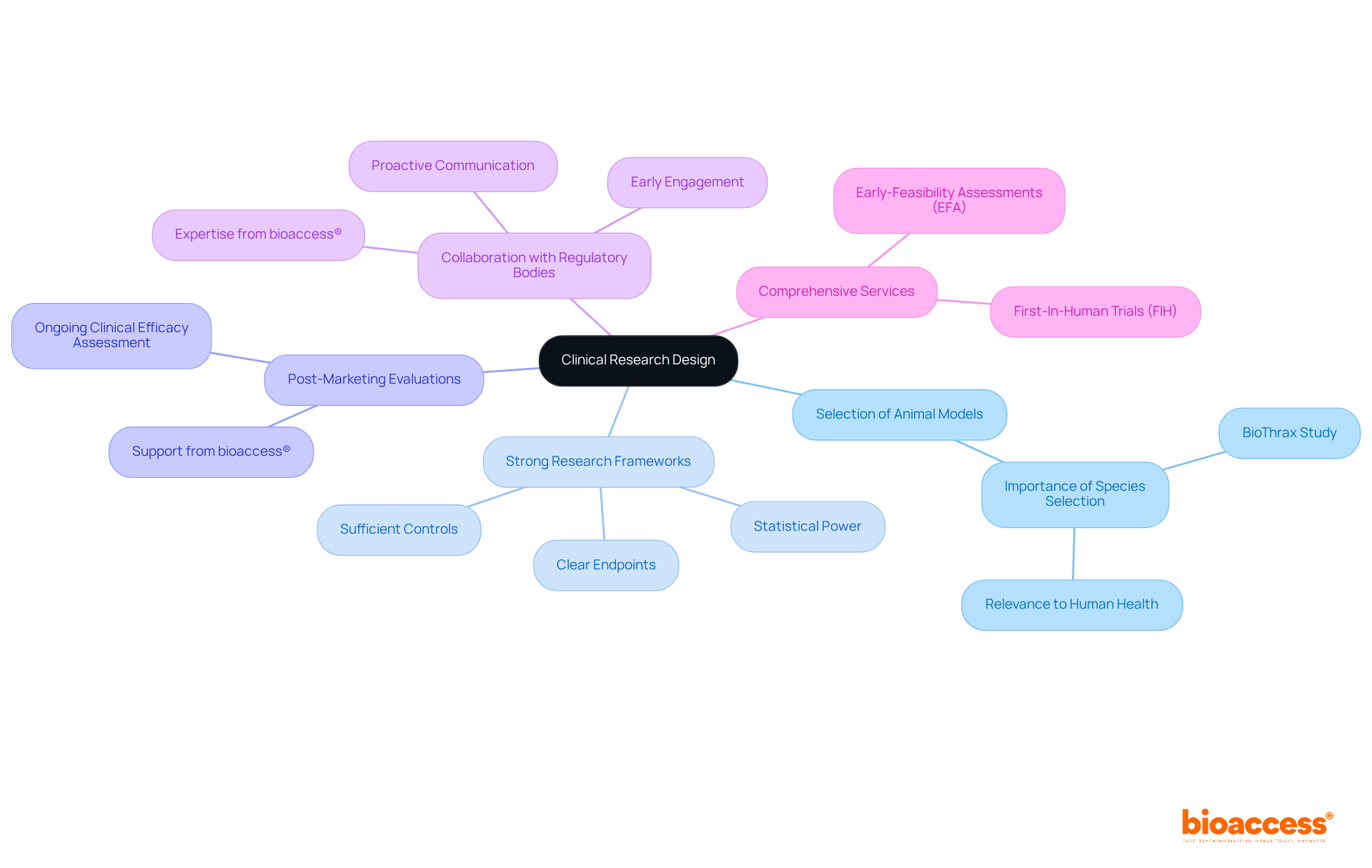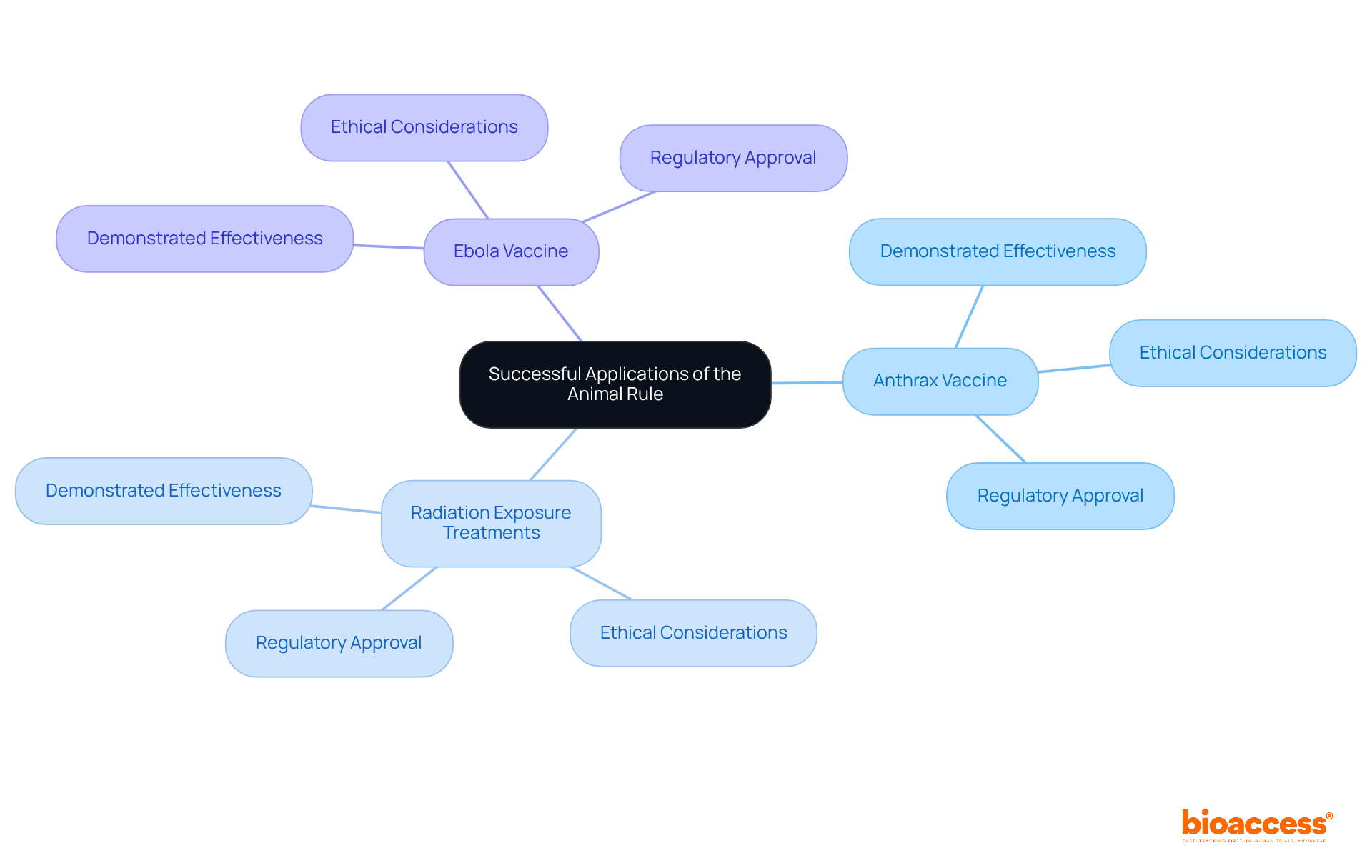


The FDA's animal rule represents a significant advancement in clinical research, allowing for the approval of essential therapies based on animal study data when human trials are impractical. This regulatory framework not only expedites the development of treatments for serious health threats but also upholds safety and efficacy through stringent scientific standards. As leaders in clinical research navigate the complexities of this rule, they confront a crucial question: how can they effectively utilize the animal rule to boost drug approval rates while ensuring ethical integrity and compliance?
The FDA's animal rule, established in 2002, plays a pivotal role in endorsing medications and biological products based on animal research evidence, particularly when human efficacy trials are deemed unethical or impractical. This regulation is essential for developing treatments for serious or life-threatening conditions, especially those linked to chemical, biological, radiological, and nuclear threats. By allowing the use of validated animal models, the regulation accelerates the advancement of medical countermeasures and vital therapies, ensuring that safety and effectiveness are rigorously assessed through well-regulated research.
As we look ahead to 2025, the impact of the animal rule FDA guidelines on clinical research remains profound. They continue to streamline the drug authorization process for products that address urgent public health needs. A notable example is TPOXX, which has been authorized for smallpox therapy. This case illustrates the effective application of the animal rule FDA, demonstrating significant efficacy in studies involving animals that could not ethically be replicated in humans. Such pathways have proven crucial in enhancing drug approval rates, particularly for conditions where traditional clinical trials are not viable.
Experts emphasize the importance of the animal rule FDA in clinical research. They are recognized as a vital mechanism for balancing the urgent need for access to life-saving therapies with the critical requirement of ensuring patient safety. Industry leaders highlight that these guidelines reflect a careful consideration of risk and benefit, especially in situations where the consequences of inaction could be dire.
For clinical research leaders, understanding the nuances of the animal rule FDA is imperative. This knowledge not only aids in navigating regulatory compliance but also empowers organizations to effectively utilize this pathway, accelerating the development of essential treatments while upholding high scientific and ethical standards. The ongoing dialogue between the FDA and sponsors developing products under this rule underscores the necessity for early and continuous communication, further enhancing the potential for successful outcomes in clinical research.

The application of the animal rule FDA is crucial for clinical research, contingent upon meeting specific criteria:
By adhering to these criteria, clinical researchers can ensure their investigations align with FDA expectations, promoting a smoother authorization process. Notably, a significant percentage of drugs have successfully met these criteria, with FDA guidance emphasizing that products must demonstrate effectiveness in animal studies according to the animal rule FDA to be considered for approval. As Holly Trochet states, "If all of these criteria are met, it is reasonable to expect the effectiveness of the drug in animals to be a reliable indicator of its effectiveness in humans."
Moreover, the FDA has released comprehensive and indication-specific guidelines to assist sponsors in navigating product development under the animal rule FDA regulations. This highlights the importance of adherence in the regulatory environment, ensuring that clinical research not only meets standards but also advances medical innovation.

Designing clinical research under the animal rule FDA requires careful consideration of several pivotal factors that can significantly impact outcomes.
Selection of Animal Models: Choosing the right animal models that accurately mimic human disease pathology is essential. This selection directly influences the relevance of research findings to human health outcomes. For instance, the critical research for BioThrax involved both rabbits and non-human primates, highlighting the importance of species selection in determining protective efficacy.
Strong Research Frameworks: Effective research frameworks must include sufficient controls and statistical power to convincingly demonstrate efficacy. Clear endpoints that relate to human benefits are crucial for meeting the criteria of the animal rule FDA. bioaccess® specializes in managing essential research, ensuring that these designs are meticulously crafted to meet regulatory expectations.
Post-Marketing Evaluations: Researchers should anticipate the need for post-marketing evaluations to further assess clinical efficacy once the product receives approval. This ongoing evaluation is vital, especially for products developed under the animal rule fda, as it ensures continued safety and effectiveness in the human population. bioaccess® provides extensive post-market clinical follow-up investigations (PMCF) to support this critical phase of research.
Collaboration with Regulatory Bodies: Engaging with regulatory agencies early in the design process can significantly enhance the likelihood of meeting all necessary guidelines. Proactive communication aids in clarifying expectations and facilitates smoother endorsement pathways. With over 20 years of experience in Medtech, bioaccess® offers the expertise needed to navigate these regulatory landscapes effectively.
Comprehensive Services: In addition to pivotal research, bioaccess® provides Early-Feasibility Assessments (EFA) and First-In-Human Trials (FIH), which are essential for evaluating the viability of new medical devices early in the development process.
By addressing these essential factors and leveraging the specialized services offered by bioaccess®, clinical researchers can significantly enhance their chances of achieving successful results and obtaining regulatory consent.

Numerous significant case examples illustrate the effective implementation of guidelines regarding animals. First, consider the endorsement of the anthrax vaccine, which utilized animal research to demonstrate its effectiveness against a substantial bioterrorism risk. Next, the development of treatments for radiation exposure highlights a scenario where human trials were not feasible due to ethical concerns. Additionally, the licensure of a vaccine for the Ebola virus relied heavily on animal data to support its effectiveness.
These cases underscore the critical role of well-designed animal studies in providing the necessary evidence for regulatory approval. They showcase how the animal rule FDA can facilitate the rapid development of essential medical countermeasures. By understanding these examples, we can appreciate the importance of collaboration in clinical research and the next steps needed to advance medical innovation.

The FDA's animal rule stands as a pivotal framework for advancing medical therapies when human trials are not feasible due to ethical considerations. By allowing validated animal research to demonstrate efficacy, this regulation not only accelerates the approval process for life-saving treatments but also upholds high standards of safety and effectiveness. For clinical research leaders, understanding and navigating this rule is essential to meet urgent public health needs.
Key insights reveal the stringent criteria necessary for the animal rule's application, including:
Successful case studies illustrate the rule's effectiveness in facilitating the development of critical therapies, such as vaccines for anthrax and Ebola virus, underscoring the importance of well-designed animal studies in securing regulatory approval.
Given these considerations, clinical research professionals must view the animal rule as a strategic opportunity rather than a hurdle. By fostering early communication with regulatory bodies and adhering to best practices in research design, organizations can enhance their chances of successful drug development while contributing to the broader mission of public health innovation. The significance of the animal rule transcends mere compliance; it embodies a commitment to advancing science while prioritizing patient safety and ethical standards in clinical research.
What is the purpose of the FDA's animal rule?
The FDA's animal rule, established in 2002, allows for the endorsement of medications and biological products based on animal research evidence when human efficacy trials are considered unethical or impractical. It is crucial for developing treatments for serious or life-threatening conditions, particularly those related to chemical, biological, radiological, and nuclear threats.
How does the animal rule impact the development of medical countermeasures?
The animal rule facilitates the use of validated animal models, which accelerates the advancement of medical countermeasures and vital therapies. It ensures that safety and effectiveness are rigorously assessed through well-regulated research.
Can you provide an example of a product authorized under the animal rule?
An example of a product authorized under the animal rule is TPOXX, which has been approved for smallpox therapy. This case demonstrates the effective application of the animal rule, showing significant efficacy in animal studies that could not ethically be replicated in humans.
Why is the animal rule important for clinical research?
The animal rule is important for clinical research as it balances the urgent need for access to life-saving therapies with the critical requirement of ensuring patient safety. It enhances drug approval rates, especially for conditions where traditional clinical trials are not feasible.
What should clinical research leaders understand about the animal rule?
Clinical research leaders should understand the nuances of the animal rule to navigate regulatory compliance effectively. This knowledge helps organizations utilize the pathway to accelerate the development of essential treatments while maintaining high scientific and ethical standards.
How does the FDA engage with sponsors developing products under the animal rule?
The FDA emphasizes the necessity for early and continuous communication with sponsors developing products under the animal rule, which enhances the potential for successful outcomes in clinical research.